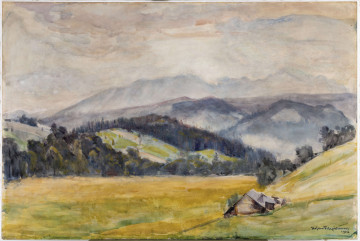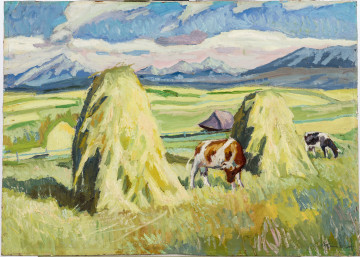
Mountainscape
1992 — 1922
National Museum in Lublin
Part of the collection: European classics of modernity
Emil Krcha came from the multi-cultural and multi-ethnic sub-Carpathian Eastern Galicia. In his hometown Kałusz, which belonged to Stanisławów Voivodeship of the Second Polish Republic in the interwar period, more than 75% of inhabitants were Ruthenian-speaking Greek Catholics. To the south of the Kałusz region stretched the borderland of the Hutsul Region. They were discovered at the beginning of the 19th century by writers and regionalists such as Wincenty Pol, Józef Korzeniowski or Eugeniusz Brocki, who were joined in the second half of the century by realist painters: Józef Simmler, Juliusz Kossak and especially Józef Jaroszyński, who settled permanently in Delatyń on the Prut River. The Eastern Carpathians became most famous for the works of artists from the turn of the 19th and 20th century, such as Stanisław Dębicki, Teodor Axentowicz and three graduates of the Academy of Fine Arts in Kraków, called Hutsuls: Kazimierz Sichulski, Władysław Jarocki and Fryderyk Pautsch. Their popularity reached long into the interwar period, whose representative was Stanisław Vincenz, a philosopher, translator, prose writer and essayist, author of the tetralogy entitled Na wysokie połoninie [In the High Mountain Pasture] (1936-1979). Both the activity of Hucul Kamocki, whose academic studio Krcha passed through in the years 1919-1925, and the fashion for Pokucie folk art influenced the interests of the painter living in Krzemieniec. There, as an exhibition-active member of the Zwornik Association of Artists in Kraków, he worked at the famous Krzemieniec High School, at which he founded the Drawing Holiday Centre in 1936. He introduced his students to Hutsul woodcarving and ceramics, glass painting, icons and folk flags and religious paintings painted on canvas. The simplifications of naive art, the compactness of the composition, and the intense colouring were also evident in Krcha's own work. Pejzaż huculski [The Hutsul Landscape] from the Szczecin collection was created based on an elaborate formula: the most important concise shapes such as rocks in the water, trees, mountain peaks were arranged backstage like theatrical decorations, drawing the viewer's eye into the meandering stream.
Szymon Piotr Kubiak
Author / creator
Dimensions
cały obiekt: height: 63 cm, width: 77 cm
Object type
painting
Creation time / dating
Creation / finding place
Identification number
Location / status

1992 — 1922
National Museum in Lublin

1901 — 1950
National Museum in Lublin

1936
National Museum in Lublin
DISCOVER this TOPIC
National Museum in Lublin
DISCOVER this PATH
Educational path